Owners, Not the Enslaved, Needed Wake-Up Call
How Cuba’s Independent Journos Get the News Out
Sleets to Succeed Hudson as Newsday Editor
Armstrong Williams Rejects Guild Criticism
Dallas Paper Profiling Each Violent Crime Fatality
Which Was the Real ‘Deadliest Mass Shooting’?
Biden’s Black Support Sags, but It’s Complicated
Barkley Says Next Season Is Last for TNT Show
Black Execs Link DEI to Job Satisfaction
Business Journos Get Paid, Expect More Diversity
Short Takes: Washington Post; capitalizing “B” in “Brown” people; Sara Sidner; Atlanta Journal-Constitution’s “new and definitive source for Atlanta Black culture”; remembering Angela Bofill with NABJ; Charlotte Post’s Robert Johnson; GM advertising in Black media; Blacks and “intentional” institutional bias; American Magazine Awards;
Avoiding the news; Lydia Polgreen, Byron Allen, MLK50 at Mirror Awards; E&P’s “15 over 50”; Kelly Virella; Mary Suh; Lalo Alcoraz; Nikole Hannah-Jones; Vicki Gonzalez; students’ investigation into Indigenous remains; Sean Combs; Carlos Watson; assault in Democratic Republic of Congo
Homepage photo: Florida A&M University marching band during a battle of the bands at the Juneteenth celebration Saturday in the SoFa District of San Jose, Calif. (Credit: Karl Mondon/Bay Area News Group)
Support Journal-ismsDonations are tax-deductible.
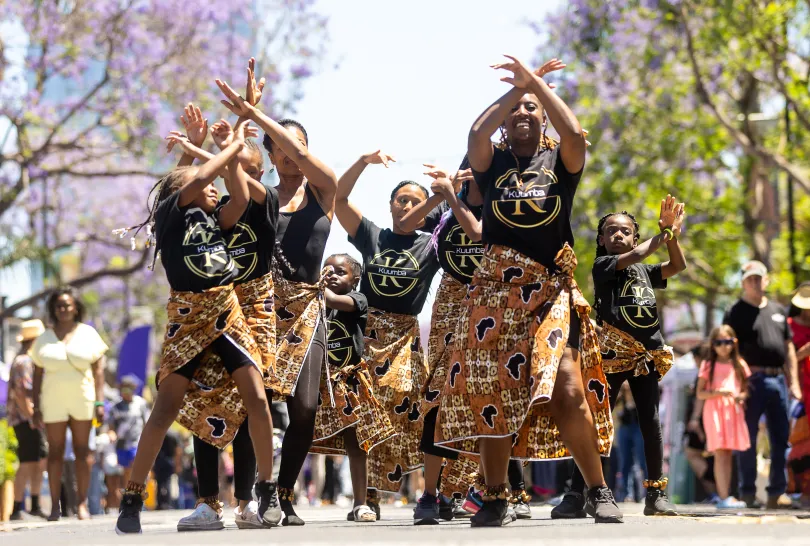
The Kuumba dance group opens up the entertainment at the Juneteenth celebration Saturday in the SoFa District of San Jose, Calif. (Credit: Karl Mondon/Bay Area News Group)
Owners, Not the Enslaved, Needed Wake-Up Call
- Also: H.L. Gates Jr.: Why Popular Juneteenth Story Strains Credulity (second item) (June 23)
Three years after this column discussed reports by historians that the media version of the origin of Juneteenth — that the enslaved people in Galveston County, Texas, did not find out about the Emancipation Proclamation until Union troops told them they were free — was a myth, the false version continues.
Even the Rev. Al Sharpton, the civil rights leader who is president of his National Action Network, repeated the notion on his “PoliticsNation” show Sunday on MSNBC.
In a typical passage, labeled “everything you need to know about Juneteenth, newest federal holiday, ” the Journal & Courier in Lafayette, Ind., tells readers, “Juneteenth is a holiday marking slaves in Texas learning in 1865 that they had been freed by President Abraham Lincoln’s Emancipation Proclamation. The executive order outlawed slavery in Confederate states beginning Jan. 1, 1863, the midpoint of the Civil War.”
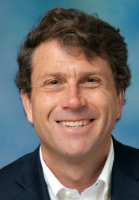 In fact, those who were enslaved knew about the proclamation; it was the recalcitrant white slaveowners who had to be told by the troops that they could not continue to hold slaves, Gregory P. Downs (pictured), history professor at University of California – Davis, told Journal-isms for that 2021 column.
In fact, those who were enslaved knew about the proclamation; it was the recalcitrant white slaveowners who had to be told by the troops that they could not continue to hold slaves, Gregory P. Downs (pictured), history professor at University of California – Davis, told Journal-isms for that 2021 column.
Downs had written about the myth in 2015, citing other historians and historical sources. Since then, he said, others had added to the scholarship.
After a telephone conversation with Journal-isms, Downs underscored by email, “I just wanted to emphasize that the piece I wrote in 2015 drew on the work of lots of scholars so I do want to make sure I emphasized that. I didn’t discover it! We are all following in DuBois’ wake and trying to catch up.”
The reference was to scholar and journalist W.E.B. Du Bois, one of several historians aware that the enslaved people kept abreast of Civil War developments.
More appropriately, many mentions of Juneteenth now simply refer to it as a celebration of the end of slavery. Journal-isms asked Downs Monday why he thinks the myth continues.
It’s “a good question. This gets into things like reception theory and communication practice that are beyond my expertise,” the historian responded. “My cynical answer would be human nature and the stickiness of received wisdom, especially if that wisdom seems to serve some purpose. As we discussed, understanding that the issue of June 19 was one of power not information actually makes Juneteenth, in my opinion, even more powerful as a celebration, but it’s a hard notion to displace.”
Opal Lee is an activist who advocated for Juneteenth to become a federal holiday. She later gained the title as the “Grandmother of Juneteenth.” Here, NBC News’ Zinhle Essamuah talks to Lee about her activism and the significance of the holiday. (Credit: NBC News/YouTube)
Power?
Downs had written, “The internecine conflict and the institution of slavery could not and did not end neatly at Appomattox or on Galveston Island. Ending slavery was not simply a matter of issuing pronouncements. It was a matter of forcing rebels to obey the law. To a very real extent, the Emancipation Proclamation and the 13th Amendment amounted to promissory notes of freedom. The real, on-the-ground work of ending slavery and defending the rudiments of liberty was done by the freedpeople in collaboration with and often backed by the force of the US Army.
“[U.S. Major Gen. Gordon] Granger’s proclamation may not have brought news of emancipation but it did carry this crucial promise of force. Within weeks, fifty thousand U.S. troops flooded into the state in a late-arriving occupation. These soldiers were needed because planters would not give up on slavery. . . .”
Downs also wrote, “To sustain slavery, some planters systematically murdered rebellious African-Americans to try to frighten the rest into submission. A report by the Texas constitutional convention claimed that between 1865 and 1868, white Texans killed almost 400 black people; black Texans, the report claimed, killed 10 whites. Other planters hoped to hold onto slavery in one form or another until they could overturn the Emancipation Proclamation in court.
“Against this resistance, the Army turned to force. In a largely forgotten or misunderstood occupation, the Army spread more than 40 outposts across Texas to teach rebels ‘the idea of law as an irresistible power to which all must bow.’ “
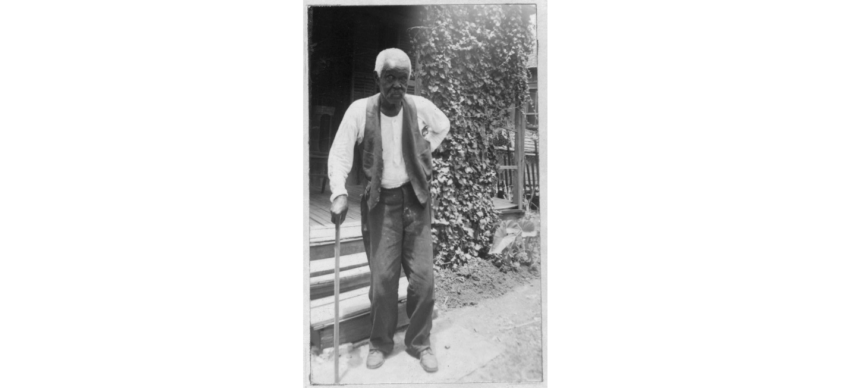
Felix Haywood, formerly enslaved, said, “They needed the Army to teach planters the futility of trying to sustain slavery.” (Credit: Library of Congress)
In their contention that the formerly enslaved knew they had been freed, historians could point to interviews with people like Felix Haywood, who was interviewed in 1936 at age 92, blind by then, in San Antonio, Texas.
“It’s a funny thing how folks always want to know about the War,” Haywood told an interviewer, his comments captured as part of the Slave Narrative Project of the larger Federal Writers’ Project.
“The war weren’t so great as folks suppose. Sometimes you didn’t knowed it was goin’ on. It was the endin’ of it that made the difference. That’s when we all wakes up that somethin’ had happened. Oh, we knowed what was goin’ on in it all the time, ‘cause old man Gudlow went to the post office every day and we knowed. We had papers in them days jus’ like now. . . .” The reference is to his former owner, William Gudlow.
Downs said, “Freedpeople, as Haywood’s quote reminds us, did not need the Army to teach them about freedom; they needed the Army to teach planters the futility of trying to sustain slavery. . . .”
Apart from Juneteenth, there are other historical myths that involve less well-known events, Downs said Monday.
“One that irritates a lot of historian friends of mine is the repeated claim in pop history that after the ‘Compromise of 1877’ the US withdrew all troops from the South. This is not only untrue but obviously untrue if anyone takes a moment to think about the location of ongoing military bases. But it serves a purpose and seems to explain things neatly, so it’s amazingly hard to dislodge.
“Another one is the idea that few white men voted until the 1820s; this is a myth based on a misreading of presidential election returns, and historians have conclusively demonstrated that white male voter participation was very high in the 1790s and even Black male participation (in the North) was higher than we thought. Thus the claim that the US was a republic that then became a democracy isn’t quite right. But it’s very hard to give up on the old narrative even for historians.”
- DeNeen L. Brown, Washington Post: Why Juneteenth didn’t actually end slavery in Texas (June 19)
- Frances “Toni” Draper, DMin, Afro American: A Time to Reflect: Why Juneteenth?
- Leila Fadel with Nathan Connolly and NPR staff, NPR: Observing Juneteenth with a reading of the Emancipation Proclamation (June 19)
- Michelle Johnson and Claude, mijohn.com: New Ancestry Collection Uses AI To Reveal Hidden Histories Of Enslaved Americans

Roberto plana Betancourt (Photo courtesy Serafin Moran)
How Cuba’s Independent Journos Get the News Out
In a Spanish-language video, Roberto plana Betancourt, a patient in his 60s, says that for more than three years, Havana’s Calixto García Hospital has never given him the attention he needed. He demonstrates in the photo above and in some showing the area in question that he urinates blood. He says he has seen several doctors, but that they are human. He blames the Cuban government for his predicament.
 Serafin Moran (pictured), an independent Cuban journalist who won asylum in the United States in 2018, explained to Journal-isms through a translator last week, “When journalists are in the streets looking for news and videos, they are detained by the Cuban regime, they scan the memories where they keep the videos and there are times when they swallow it so as not to be stripped of their work; they spend days in prison just for working as a press and when they manage to get out of the darkness they broadcast the little news they obtained.”
Serafin Moran (pictured), an independent Cuban journalist who won asylum in the United States in 2018, explained to Journal-isms through a translator last week, “When journalists are in the streets looking for news and videos, they are detained by the Cuban regime, they scan the memories where they keep the videos and there are times when they swallow it so as not to be stripped of their work; they spend days in prison just for working as a press and when they manage to get out of the darkness they broadcast the little news they obtained.”
On Sunday, Father’s Day, Moran posted on Facebook a video of an attempted robbery and trashing of a military store known as Belinda.
“Cubans try to destroy premises belonging to the Cuban regime and do it clandestinely,” Moran said. “Because you do not agree with the dictatorship, the independent press has to secretly record due to the restrictions of the Cuban regime.” He said this video as well was secretly recorded by the independent press and forwarded to him.
Writing in the Miami Herald Saturday, columnist Andres Oppenheimer quoted Carmelo Mesa Lago, a former University of Pittsburgh professor best known as “the dean of Cuban economists.”
“When I asked him how bad things are on the island, he summed it up in three words: ‘worst than ever,’ ” Oppenheimer wrote. Mesa Lago was discussing the economic crisis, rather than the human rights violations others have publicized.
“Mesa Lago, who will turn 90 in August, maintains regular contact with Cuban economists on the island. Reached at his home in Pittsburgh, he told me that ‘Cuba is going through its worst economic crisis since the 1959 revolution.’ . . .
“Mesa Lago said the U.S. embargo, which he has opposed over the years, is far from a major reason behind Cuba’s economic catastrophe. . . .
“ ‘If Cuba doesn’t make fundamental economic changes, there’s no way they can get out of the hole,’ he told me. ‘Things are likely to get even worse.’ ”
- Caribbean News Service/ Association of Caribbean States: ACS Supports Cuba’s Removal from the List of Countries Not Cooperating in Anti-Terrorism Efforts
- CiberCuba: Prosecutor’s Office requests 10 years in prison for a young Cuban woman for posts on Facebook (June 8)
- Miriam Leiva, CubaNet: Cuba, isolated in the Caribbean Sea
- Guillaume Long, Center for Economic and Policy Research: State Department’s Symbolic Step on Cuba Only Provokes Regional Frustration Over Sanctions
- William Navarrete, CubaNet: “Cuba is completely destroyed and the change will be long and difficult”
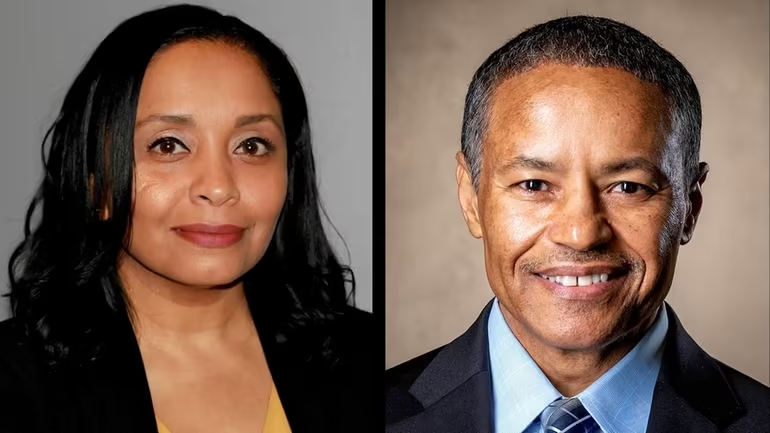
“It has been an honor and privilege to lead this incredible newsroom alongside the force that is Don Hudson,” right, said Rochell Sleets, left, who will become the first Black woman to lead Newsday, starting Sept. 16. (Credit: Newsday)
Sleets to Succeed Hudson as Newsday Editor
Managing Editor Rochell Bishop Sleets, who joined Newsday in February 2023, has been named editor and chief content officer, the first Black woman in the job, Craig Schneider reported June 6 for the Long Island, N.Y., news organization.
Sleets, 47, succeeds Don Hudson, who is retiring in September. Hudson was the first African American in the job.
“Sleets has implemented several new digital strategies, including a news alerts approach that has proved successful with audience engagement, as well as a tool for better newsroom collaboration across all platforms,” Schneider wrote.
“ ‘We are committed to telling the stories that matter to Long Island and its diverse communities,’ Sleets said. ‘I’m ready to bring my dedication and expertise to this new role to continue working with our talented crew on impactful and unique storytelling through proven and innovative channels for continued audience growth across all platforms.’ . . .
“Before coming to Newsday, Sleets was one of two news directors at the Chicago Tribune, where she worked for 16 years. At the Tribune, Sleets oversaw coverage of topics including arts and entertainment, the environment, business news and education. . . .
“Sleets grew up in New Jersey, the daughter of immigrants from Belize. Her husband, Gentry, is an engineer and former journalist. They are the parents of four adult children.
“Hudson, 62, has served as editor and chief content officer since January 2023, when he took over from Deborah Henley, who retired.
“Hudson was part of Newsday’s award-winning coverage in 2023 of the Gilgo Beach serial killings (video), as well as the series titled ‘Feeling the Squeeze: Long Island’s Cost of Living Crisis‘ (video).
Hudson came to Newsday in 2018 as an assistant managing editor in charge of topics including health, transportation, education and environment. In that role, he oversaw Newsday’s coverage of the coronavirus pandemic, Schneider reported. For many years, he kept a tally of Black executives at mainstream newspapers for the National Association of Black Journalists.
Hudson worked as a reporter and editor at publications including the Orlando Sentinel; Gannett Co. Inc., in Tennessee, Michigan and Mississippi, where he helped shape civil-rights coverage that was named a finalist for a Pulitzer Prize; and the Decatur Daily in Alabama.
Armstrong Williams Rejects Guild Criticism
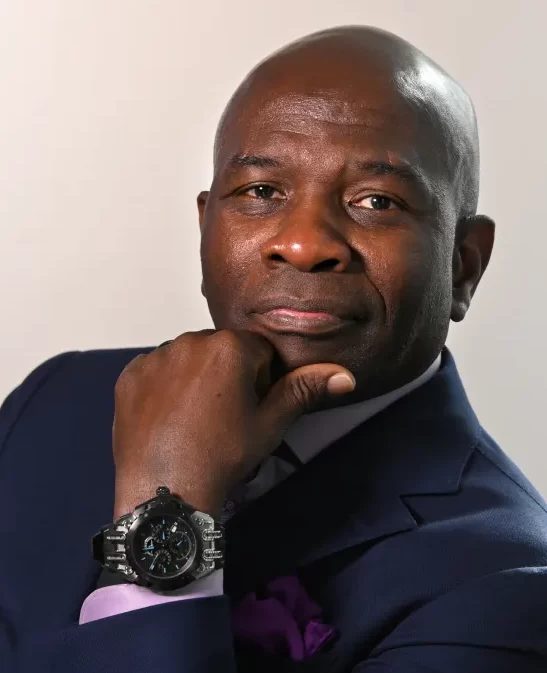 Baltimore Sun part-owner Armstrong Williams (pictured, by Lloyd Fox/Baltimore Sun) pushed back Wednesday against criticism of the newspaper’s publishing stories from the conservative Sinclair Broadcast Group, defended a story’s use of the term “illegal immigrants” and offered a justification for his own use of what the Baltimore Sun Guild called “offensive language to describe transgender people.”
Baltimore Sun part-owner Armstrong Williams (pictured, by Lloyd Fox/Baltimore Sun) pushed back Wednesday against criticism of the newspaper’s publishing stories from the conservative Sinclair Broadcast Group, defended a story’s use of the term “illegal immigrants” and offered a justification for his own use of what the Baltimore Sun Guild called “offensive language to describe transgender people.”
On June 10, the Guild demanded that the Sun:
- “Hold a meeting with all staff members to address our concerns and explain the long-term strategy for the paper, and any agreements with Fox45 or Sinclair.
- “Stop the sharing of articles, photos, videos and social media content from Fox45 and Sinclair until such a meeting can be held.
- “Ensure that all stories published in The Baltimore Sun adhere to the same journalistic standards that we are held to as union members, including The Sun’s Cultural Competency Guide created by the newsroom’s Diversity Committee.”
In a Sun op-ed piece, Williams declared that the Associated Press, whose stylebook is widely used in newsrooms, “has not been endowed by law to prescribe journalistic mandates.”
He noted that “The Sun’s co-owner David Smith is the executive chairman of Sinclair Broadcast Group, which owns FOX45, and The Guild fretted over publication by the newspaper of articles from FOX45. The FOX45 News Team has been beribboned by the Radio Television Digital News Association with regional Edward R. Murrow awards.”
Williams also said, “I do not doubt that the Guild sincerely and passionately believes its conception of enlightened journalism. The First Amendment protects that right. But I and others have an equal right to disagree and to march to our own journalistic drummers. None of us is infallible. That is why a free marketplace of ideas is indispensable to the discovery of truth.”
- David Folkenflik with Christine Condon, “Here and Now,” WBUR/NPR: Baltimore Sun Guild and leadership locked in ethics debate (June 20)
Dallas Paper Profiling Each Violent Crime Fatality
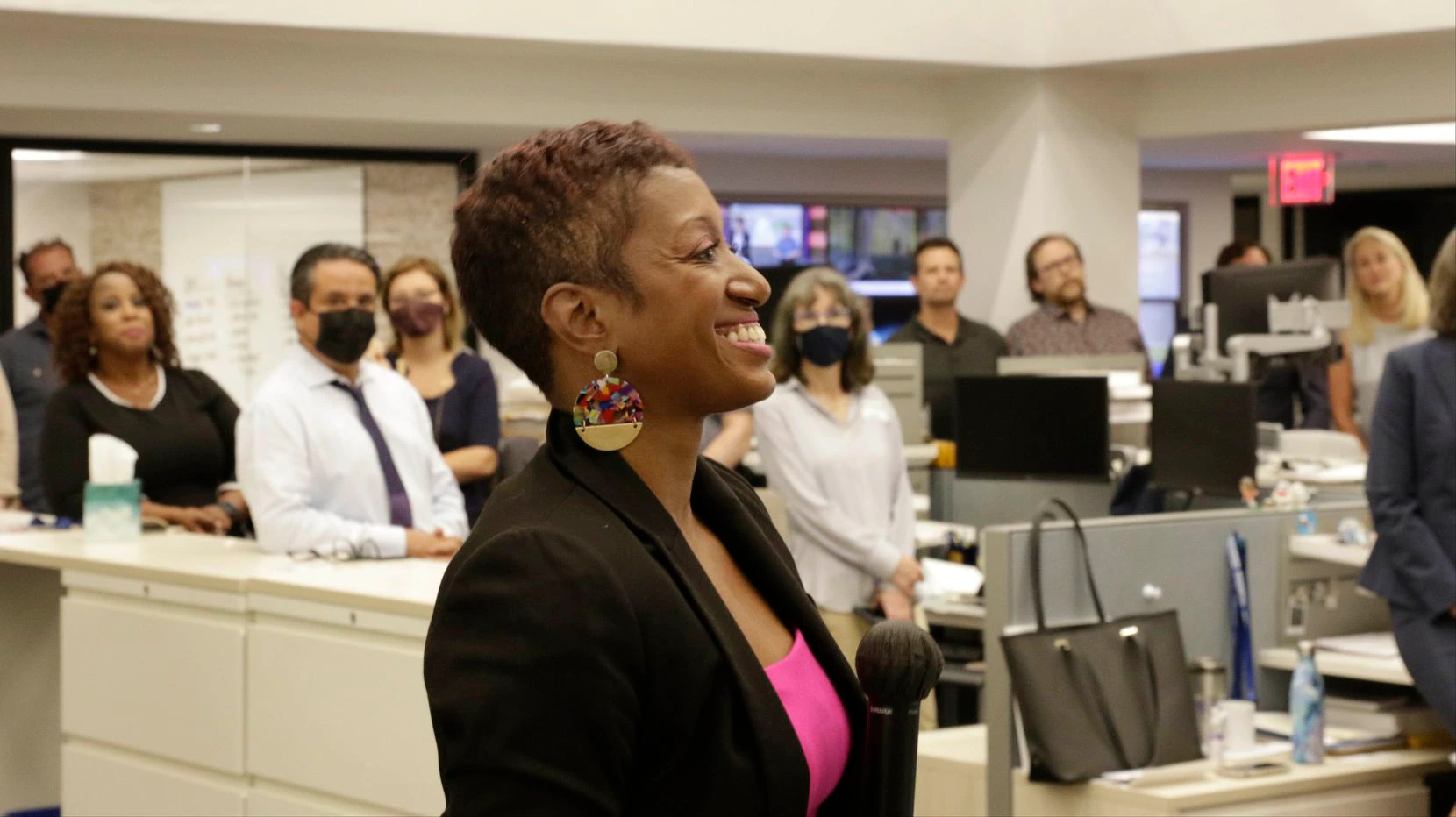 “Last year was one of the deadliest years in Dallas since 1997,” Katrice Hardy (pictured, by Irwin Thompson/Dallas Morning News), executive editor of the Dallas Morning News, wrote to subscribers Friday. “That made Dallas, unfortunately, one of the few cities around the country that experienced an increase in murders.
“Last year was one of the deadliest years in Dallas since 1997,” Katrice Hardy (pictured, by Irwin Thompson/Dallas Morning News), executive editor of the Dallas Morning News, wrote to subscribers Friday. “That made Dallas, unfortunately, one of the few cities around the country that experienced an increase in murders.
“The shocking revelation was discovered while a couple of our journalists reported on the crime trends for the year. When their story was done, the jarring statistic was also something that breaking news reporter Jamie Landers and public safety reporter Kelli Smith couldn’t shake.
“ ‘We started having bigger conversations about what this means for us as a city, and how our ability — or inability — to address what’s happening here is the difference between life and death for dozens of people,’ Kelli said.
“Their conversations prompted the DMN newsroom this year to profile every single person who dies from violent crime in Dallas.
” ‘There is often an exponential amount of attention paid to notably horrific crimes — largely mass shootings — but it’s important that we make an effort to say that while it’s a tragedy when it happens in a church or a school or an outlet mall, it’s also a tragedy when it happens to one person on a city street,’ Jamie said. ‘We are losing more than 200 people every year to acts of violence.’
“Jamie and Kelli are now joined by more than a dozen other DMN journalists who are helping profile everyone who dies this year from violent crime. The families they have spoken to have said that they often feel as if their pain has been overlooked and oversimplified. The mother of the 16-year-old son shared that a stranger stayed with him as he lay outside her apartment gasping for air after being shot. . . .
“ ‘We hope that by memorializing every life, while also probing what officials are doing to address these issues, our work can aid in the understanding that these deaths are preventable and dependent upon our community’s willingness to come and work together,’ Jamie said. ‘Last year, Dallas police Chief Eddie García told us that it had seemed as if some in the city had lost the value of human life. If even one person who has felt numb to this epidemic sees themselves or someone they love in one of these stories and asks what they can do, then we’ve done our part.’ ”
- Dallas Morning News: 2024 Homicides
The Wounded Knee Massacre of Dec. 29, 1890, was never far from mind when Native Americans made demands during protests in the 1970s. (Credit: YouTube)
Which Was the Real ‘Deadliest Mass Shooting’?
When the Supreme Court on Friday struck down a ban on bump stocks, which enable semiautomatic rifles to fire at speeds rivaling those of machine guns, some in the news media tried to put the ruling in context.
They reported that it resulted from “the nation’s deadliest mass shooting” at a Las Vegas concert in 2017 that killed 60 people and injured hundreds.
But indigenous Americans said at the time that such statements amount to erasure. Perhaps “one of the deadliest” or “in recent history” might make the context more accurate.
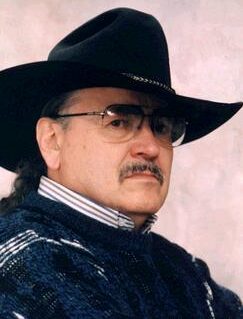 The late Tim Giago (pictured), a co-founder of what was then called the Native American Journalists Association and known as the dean of Native journalists, sent Journal-isms the list below of some of the deadliest mass killings involving indigenous people in 2016, compiled by staff writers at Native Sun News.
The late Tim Giago (pictured), a co-founder of what was then called the Native American Journalists Association and known as the dean of Native journalists, sent Journal-isms the list below of some of the deadliest mass killings involving indigenous people in 2016, compiled by staff writers at Native Sun News.
He and the news organization were urging the Lakota people to “take the lead and have a museum built at Wounded Knee to honor all of the Native Americans massacred in America.”
- “Wounded Knee 1890; 300 [Miniconjou] and Hunkpapa Lakota men, women and children were slaughtered by troops of the 7th Cavalry under Colonel James W. Forsythe.
- “Mankato 1862: 38 Mdewakantowan Dakota men were ordered to be hanged by President Abraham Lincoln for their role in the Dakota Uprising of 1862.
- “Clear Lake 1850; 60 Pomo Indians killed by General Nathaniel Lyon.
- “Ash Hollow 1855; 86 Lakota killed by General William Harney.
- “Grand Ronde 1856; 60 Cayuse killed by Colonel Benjamin Shaw.
- “Rush Spring (Wichita village); 83 Comanche killed by Colonel Earl van Dorn. The Comanche were trying to negotiate a peace settlement.
- “Bear River 1863; 278 Shoshone killed by General Patrick Edward Connor
- “Whitestone Hill 1863; 311 Yankton Nakota killed by General Alfred Sully as retaliation for the Minnesota uprising carried out by the Mdewakanton and Wahpekute Dakota. The Yankton and Yanktonai had nothing to do with the Minnesota attacks
- “Sand Creek 1864; 210 Native people –163 Cheyenne and 47 Arapaho killed by Colonel John M. Chivington. Chivington had given them permission to camp near Fort Lyon — but that was only to have them available for a massacre.
- “Powder River 1865; 63 Arapaho killed by General Patrick Edward Connor — his second massacre of Indian people. Bear River was his first and this was his encore performance.
- “Washita 1868; 111 Cheyenne killed by General George Armstrong Custer. (Private communication from a Cheyenne — Custer reported 103 killed.) — The same band — or what was left of it–that was attacked 4 years earlier at Sand Creek.
- “Marias River 1870; 217 Blackfeet killed by Colonel Eugene Baker. (Indian figures — Baker reported 173 killed.)
- “Camp Grant 1871; 144 Apache killed by a vigilante mob consisting mainly of Papago Indians and Mexicans, armed and egged on by an Anglo civilian newspaper editor, William Oury from Tucson playing “let’s you and him fight.” Make a rival tribe do your dirty work for you.
- “McClellan Creek 1873; 31 Comanche killed by Colonel Ranald Mackenzie who later died in an insane asylum.
- “Sappa Creek 1875; 27 Cheyenne killed by Lieutenant Austin Heneley.
- “Big Hole 1877; 89 Nez Perce killed by Colonel John Gibbon — but Nez Perce counter attack drove soldiers away.
- “Fort Robinson 1879; 64 Cheyenne killed trying to escape from Fort Robinson by Captain Henry W. Wessels.
“In California, there were many massacres of Indian people by civilian vigilantes, e,g. Humboldt Bay in 1860; about 310 Wiyot Wintun people killed. There were dozens of incidents like this. The once populous Cahuilla Indians were reduced from thousands to a few hundred. . . .
“The museum would have rooms set aside to display the exhibits of all of the tribes listed above to show their history and help educate not only Native Americans but visitors from all around the world.
“The museum would have rooms set aside to display the exhibits of all of the tribes listed above to show their history and help educate not only Native Americans but visitors from all around the world.
“This museum would be a place to commemorate and honor the thousands of Indian men, women and children that died at the hands of the settlers and the U. S. Cavalry and Army.”
MSNBC’s Joy Reid and her political panel discuss Black Republicans June 7 on “The ReidOut.” A majority of Black voters in USA Today/Suffolk University polls of Black voters in Michigan and Pennsylvania said they would be less likely to vote for Trump if he chose any of three Black men frequently mentioned as potential vice-presidential candidates. (Credit: YouTube)
Biden’s Black Support Sags, but It’s Complicated
“President Biden’s sagging support among Black voters has set off alarm bells among Democrats and raised hopes among Republicans that Donald Trump could score historic gains with a key part of their opposition’s base,” Susan Page reported Sunday for USA Today.
“But exclusive USA TODAY/Suffolk University polls of Black voters in Michigan and Pennsylvania, two crucial swing states, show a more complicated dynamic within a demographic group that is unexpectedly in play in November’s election.
“The surveys of 500 Black voters in each state, taken by landline and cell phone from June 9 to 13, have margins of error of plus or minus 4.4 percentage points.
“Here are seven takeaways.
“1. Yes, Biden has a problem.
“The president has suffered significant losses among Black voters who supported him in 2020. . . .
“2. But Black voters aren’t sold on Trump, not yet.
“Biden’s big losses have resulted in small gains for Trump. . . .
“3. Kamala Harris is less popular than Biden . . .
“4. For Trump, choosing a Black running mate could backfire.
“A majority of Black voters, with percentages ranging from 55% to 59%, said they would be less likely to vote for Trump if he chose any of three Black men frequently mentioned as potential vice-presidential candidates: former Housing and Urban Development Secretary Ben Carson, South Carolina Sen. Tim Scott and Florida Rep. Byron Donalds. . . .
“5. Trump as a fellow victim of injustice? Not so much. . . .
“6. The verdict: Lock him up.
“Almost two-thirds of Black voters in each state − 64% in Michigan and 65% in Pennsylvania − said Trump’s conviction in New York on charges of falsifying business records in a hush-money scheme made them less likely to vote for him. . . .
“7. For the disaffected, third parties have new appeal.
“In 2020, just 1% of those surveyed said they voted for a third-party candidate. Now the drift from Biden has swelled that number to 15% in Michigan and 16% in Pennsylvania. . . .
- Perry Bacon Jr., Washington Post: Justice Alito is right about today’s politics
- Philip Bump, Washington Post: Trumpworld keeps overstating Trump’s support among Black voters
- Charles M. Blow, New York Times: How a Group of Rappers Became Trump Evangelists (May 29)
- Robin Givhan, Washington Post: Donald Trump deigns to see Black voters now
- Kadia Goba, Semafor: ‘They see strength’: The Black sports icons shaping Donald Trump’s take on race, politics, and masculinity
- LZ Granderson, Los Angeles Times: A Trump running mate who praises Jim Crow? That’s a red flag
- Talia Jane, New Republic: Trump Visits Detroit to Court Black Voters — and Flops Big-Time
- Erik Ortiz, NBC News: Right-wing media reckoning: Some outlets pay a price after spreading 2020 election misinformation
- Eugene Robinson, Washington Post: Is Donald Trump okay?
- Juan Williams, The Hill: Only a free press can save us from a second Trump term
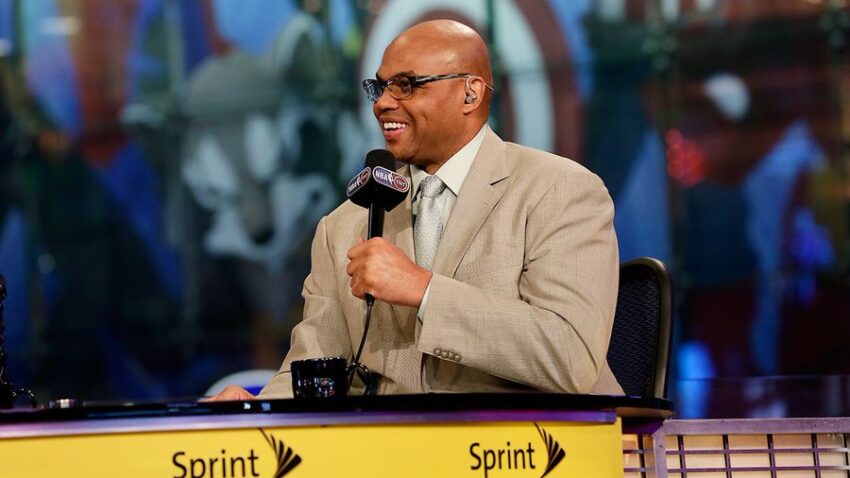
“A member of the Sports Broadcasting Hall-Of-Fame, Barkley co-hosts the Inside The NBA show — which airs during halftime and after TNT NBA game telecasts — along with Kenny Johnson, Shaquille O’Neal and Kenny Smith,” R. Thomas Umstead wrote for Broadcasting and Cable. “TNT in a statement called Barkley a ‘broadcasting icon,’ and added that the network looks to “further discussion of our future plans with him.’ ” (Credit: ESPN)
Barkley Says Next Season Is Last for TNT Show
“Charles Barkley says next season will be his final one on TV,” ESPN reported Saturday.
“Barkley, part of the highly popular, award-winning ‘Inside the NBA’ studio show, said Friday night that the 2024-25 season will be his last with TNT and that he won’t be joining any other network beyond that either.
” ‘I ain’t going nowhere other than TNT,’ Barkley, 61, said on NBATV after the Dallas Mavericks’ Game 4 victory over the Boston Celtics on Friday night. ‘But I have made the decision that, no matter what happens, next year is going to be my last year on television. And I just want to say thank you to my NBA family. You guys have been great to me. My heart is full with joy and gratitude.’
“The NBA has been negotiating its next media rights deals, which would begin in the 2025-26 season. While the NBA hasn’t announced what the deals will look like, Disney/ABC/ESPN, Amazon, NBC and Warner Bros. Discovery have been vying for what’s reported to be three available packages of games and affiliated content worth an estimated $76 billion to the league over a decade.
“If Warner Bros. Discovery is the odd media company out, it would mean the end of games on TNT and no more ‘Inside the NBA.’ . . .”
- Jon Lewis, Sports Media Watch: All the times Charles Barkley said he would retire

Where Anti-DEI Legislation Has Been Proposed: Gray represents no bill; light green, introduced; dark green, final legislative approval or signed into law; brown means tabled, failed to pass or vetoed. (Credit: Chronicle of Higher Education)
Black Execs Link DEI to Job Satisfaction
“Amid the rising tension and legal challenges against diversity, equity, and inclusion (DEI) initiatives, a new survey by The Executive Leadership Council,” an association of nearly 800 Black executives, “reveals a resilient commitment to business enhancing DEI,” the council reported June 5.
[Separately, Taylor Telford, Emmanuel Felton and Emily Guskin reported Tuesday for The Washington Post, “most Americans approve of companies taking steps to address the historic inequalities in their ranks, according to a poll from The Washington Post and Ipsos. Roughly 6 in 10 Americans said that diversity, equity and inclusion programs are ‘a good thing’ — and support was even higher for specific programs such as internships for underrepresented groups and anti-bias trainings.
[“The level of support differed among racial groups, and one effort was universally unpopular: financial incentives for managers who achieve diversity goals.” . . .]
The Executive Leadership Council survey, “released during The ELC’s annual Summer Member Meeting, identified the best ways to improve DEI across Corporate America. In addition to maintaining or increasing ethnic diversity at all levels of leadership and management, three main themes emerged as the most effective approaches for companies moving forward:
- ‘Treat DEI like other known business drivers in companies.
- “Instill clear measurement mechanisms to determine and reinforce which DEI strategies work best to drive business outcomes.
- “Remain steadfast in support of DEI to grow the business even as anti-DEI fervor increases.”
As of May 24, the Chronicle of Higher Education reports that since 2023, 85 anti-DEI bills have been introduced in state legislatures and in Congress, 14 have become law, 14 have final legislative approval, and have been tabled, failed to pass, or vetoed.
- Black Enterprise: The Benefits Are On The Balance Sheet: Corporate America Must Stand By DEI And Chief Diversity Officers
- John Celestand, Word in Black: Stop Asking Black Student Athletes to Fix America’s DEI Mess (June 10)
- Sage Howard, HuffPost: Grants For Black Women Entrepreneurs Are Not ‘Discriminatory’
- Eric Hoover, Chronicle of Higher Education: After the End of Race-Conscious Admissions, Application Trends Didn’t Shift. But the Analysis Has Just Begun.
- Natalie Korach, The Wrap: The Hollywood Reporter Lays Off Legacy TV Editor Lesley Goldberg Among Other Staffers; Rebecca Sun, senior editor of diversity and inclusion, was also laid off
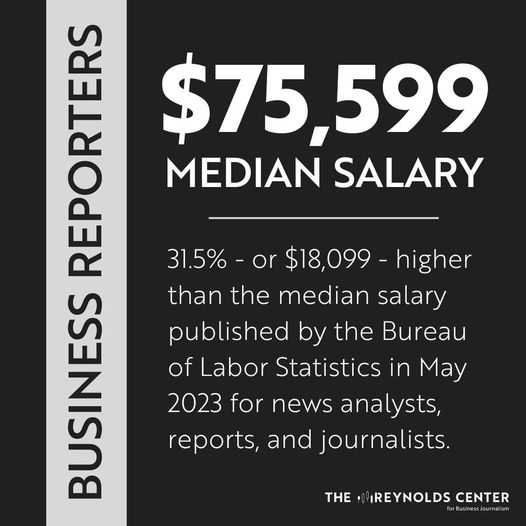
“While 85.3% of journalists who were 35 and older selected White as their sole race/ethnicity, only 70.5% of journalists under the age of 35 selected White. For journalists under 30, that number drops down to 57.8%.” (Credit: Reynolds Center)
Business Journos Get Paid, Expect More Diversity
“Business journalists continue to earn an impressive premium over their general-news peers, while demographic data indicate a strong cohort of female business journalists is making its way up the ranks,” along with those from diverse racial backgrounds, according to the most recent salary survey from the Reynolds Center for Business Journalism, reports Arizona State University’s Walter Cronkite School of Journalism and Mass Communication.
“Front-line business journalists – reporters, correspondents, and freelancers – who responded to the survey, conducted from April 15 to May 1, 2024, reported a median salary of $75,599,” the school said June 3. “That’s $18,099 higher – or 31.5% more – than the median salary published by the Bureau of Labor Statistics for news analysts, reporters, and journalists in May 2023 – the most recent data available at the time of publishing. This is the third consecutive year the Reynolds Center has conducted this survey and demonstrates a clear and consistent premium in the salaries reported by business reporters. . . .
“Similar to the 2023 salary survey results, younger respondents in this year’s survey were more likely to be women and from diverse racial backgrounds than their older counterparts. While 85.3% of journalists who were 35 and older selected White as their sole race/ethnicity, only 70.5% of journalists under the age of 35 selected White. For journalists under 30, that number drops down to 57.8%.
“Additionally, while women only accounted for 43.4% of journalists that were 35 and older, they represented 70% of journalists under the age of 35 in the survey, and 80% of those under the age of 30. These results point towards a future field of business journalists that is more representative of the communities it serves than previous generations. . . .”
Short Takes
- “The publisher and the incoming editor of The Washington Post, when they worked as journalists in London two decades ago, used fraudulently obtained phone and company records in newspaper articles, according to a former colleague, a published account of a private investigator and an analysis of newspaper archives,” Justin Scheck and Jo Becker reported Saturday for The New York Times, in one of many revelations about the new Post team by news outletsin the last week. “Will Lewis, The Post’s publisher, assigned one of the articles in 2004 as business editor of The Sunday Times. Another was written by Robert Winnett, whom Mr. Lewis recently announced as The Post’s next executive editor. . . . “
- “We’re capitalizing the B in both Black and Brown,” the New York Amsterdam News announced Thursday. “Our coverage tends to look at issues that affect Black and Brown communities: Our readers know whom we are talking about when we write that descriptive phrase,” the editorial said. “When we capitalize Brown, we are honoring and respecting a community as we name it.” Damaso Reyes, executive and investigative editor, told Journal-isms, “We’re still developing our style guide (this is part of that process).”
- “Two mastectomies, more than 15 rounds of chemotherapy and radiation therapy later, CNN’s Sara Sidner returned to her show on Thursday,” Owen Lavine reported Thursday for the Daily Beast. “Sidner told People magazine she underwent a mammogram after finding a lump on her breast just before she departed on a three-week reporting trip to Israel in October 2023. While abroad, Sidner’s mammogram came back with some concerning results. Upon returning to New York, her fears were realized. She was diagnosed with stage-three breast cancer. . . .”
 The Atlanta Journal-Constitution Tuesday launched UATL, “a new and definitive source for Atlanta Black culture, brought to life through stories, videos, events, experiences, partnerships and more.” Mike Jordan is senior editor; Ernie Suggs is senior reporter. The announcement said, “UATL features will include The Line Up, a weekly top-five of Black culture event recommendations, along with news reports, interviews, profiles, opinion columns and other cultural coverage. UATL also will host special events, including the Black Culture Night film series, screening ‘Love & Basketball’ June 25, ‘School Daze’ Sept. 24 and ‘The Best Man Holiday’ Dec. 10. A new partnership with the Atlanta Dream includes event promotions during the team’s Culture Nights and collaboration on voter education initiatives. . . . “
The Atlanta Journal-Constitution Tuesday launched UATL, “a new and definitive source for Atlanta Black culture, brought to life through stories, videos, events, experiences, partnerships and more.” Mike Jordan is senior editor; Ernie Suggs is senior reporter. The announcement said, “UATL features will include The Line Up, a weekly top-five of Black culture event recommendations, along with news reports, interviews, profiles, opinion columns and other cultural coverage. UATL also will host special events, including the Black Culture Night film series, screening ‘Love & Basketball’ June 25, ‘School Daze’ Sept. 24 and ‘The Best Man Holiday’ Dec. 10. A new partnership with the Atlanta Dream includes event promotions during the team’s Culture Nights and collaboration on voter education initiatives. . . . “
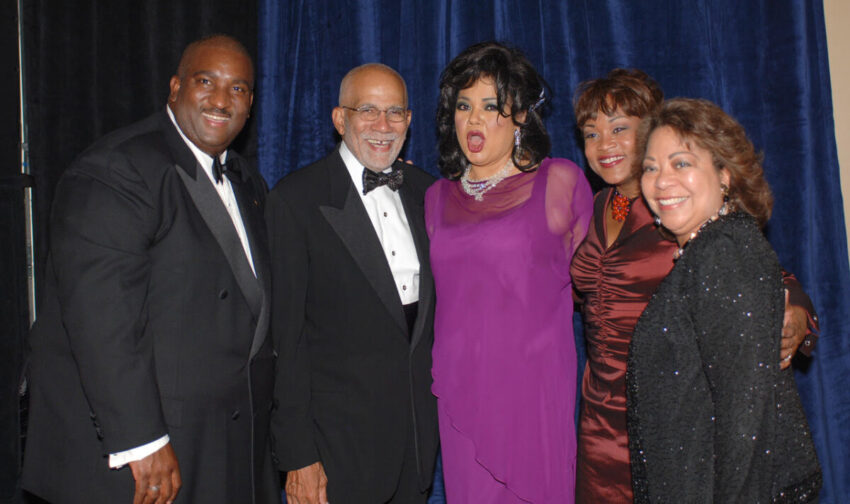
- Angela Bofill, who died Thursday in Vallejo, Calif., at 70, was part of the Salute to Excellence Awards of the National Association of Black Journalists in Washington on Oct. 15, 2005. “With a silky blend of Latin, jazz, adult-contemporary and soul, Ms. Bofill is best remembered for jazzy love songs like ‘This Time I’ll Be Sweeter’ and funk-inflected pop numbers like ‘Something About You,’ ” Alex Williams wrote Monday, updated Tuesday, in The New York Times. “Armed with a three-and-a-half-octave range, her voice was ‘as cool as sherbet, creamy, delicately colored, mildly flavored,’ as Ariel Swartley wrote in Rolling Stone magazine in 1979.” Wearing purple, Bofill is flanked by, from left, NABJ President Bryan Monroe and journalists Ed Bradley, Barbara Ciara and Lynn Norment. (Photo credit: Jason Miccolo Johnson)
The Charlotte Post is the city’s oldest Black publication.
- Charlotte (N.C.) Post “co-publisher and general manager Robert Johnson, who with his brother Gerald positioned the publication’s role as a community resource beyond journalism, died today at age 84,” Herbert L. White reported for the Post on June 5. “Mr. Johnson served many roles at The Post, including columnist, circulation manager and ad sales representative since his father Bill bought the publication in 1974. When Bill Johnson died in 1986, Gerald Johnson took over day-to-day leadership of the business while Robert was the public face who connected with readers, subscribers and advertisers – often simultaneously. He was also integral to The Charlotte Post Foundation, which operates the Top Seniors initiative that salutes academic excellence for Black high school seniors in Charlotte-Mecklenburg public schools. . . .” (Credit: YouTube)
- “General Motors is on track to reach its goal of 8% of its advertising placed with Black-owned media by 2025,” Tanya Gazdik reported June 9 for Media Post’s Marketing Daily. “That’s according to executives from the automaker who were on hand at the Black Owned Media Weekend in Detroit, hosted by the Black Owned Media Equity and Sustainability Institute. The nonprofit emphasizes the importance of Black owned media in the industry and best practices for building a sustainable future. . . . “
- “A new analysis suggests that many Black Americans believe the racial bias in U.S. institutions is not merely a matter of passive negligence; it is the result of intentional design,” Kiana Cox reported Saturday for the Pew Research Center. “Specifically, large majorities describe the prison (74%), political (67%) and economic (65%) systems in the U.S., among others, as having been designed to hold Black people back, either a great deal or a fair amount. . . .”
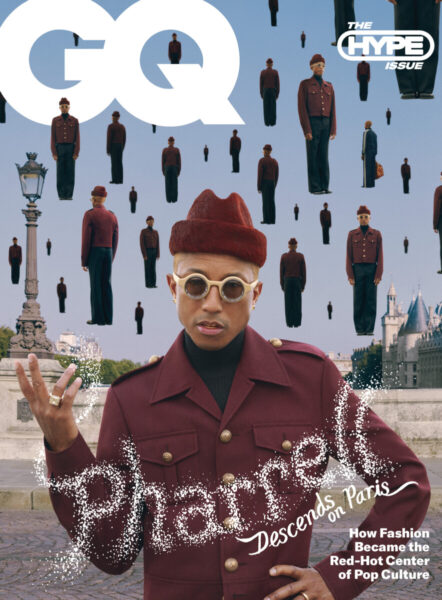
- This September 2023 cover of GQ won in the “2024 Best Cover” contest of the American Society of Magazine Editors, announced Monday, in the “best fashion, beauty and style” category.” Will Welch, global editorial director; Robert Vargas, art director; Roxanne Behr, photography editor; and Fanny Latour-Lambert, photographer, were cited. People of color were represented on winning covers in other categories.
- “The proportion of people selectively avoiding the news is now ten percentage points higher than it was seven years ago, reaching a new high of 39% across 20 key markets,” Charlotte Tobitt reported Monday for Britain’s Press Gazette. “This is the highest level of news avoidance recorded since the Digital News Report by the Reuters Institute for the Study of Journalism began in 2012. Previously the high was 38% in 2022. In the past year selective news avoidance has grown by three percentage points. The biggest increases were in Ireland (up by ten percentage points to 44%), Spain (+8pp to 37%), Italy (+7pp to 36%), Germany (+5pp to 37%), Finland (+5pp to 26%), the US (+5pp to 43%) and Denmark (+4pp to 23%). . . .”
 Lydia Polgreen (pictured), Byron Allen and the MLK50: Justice Through Journalism project were among the winners Thursday at the Mirror Awards, held in New York and presented by Syracuse University’s S.I. Newhouse School of Public Communications. Polgreen won for best commentary for “It’s Not a Good Sign When People Who Don’t Pay for News Have So Little to Choose From” [PDF] in The New York Times; Allen won the Fred Dressler Leadership Award and MLK50 was given the Lorraine Branham IDEA Award. “Established by the Newhouse School in 2006, the Mirror Awards honor the reporters, editors and teams of writers who hold a mirror to their own industry for the public’s benefit,” the school says.
Lydia Polgreen (pictured), Byron Allen and the MLK50: Justice Through Journalism project were among the winners Thursday at the Mirror Awards, held in New York and presented by Syracuse University’s S.I. Newhouse School of Public Communications. Polgreen won for best commentary for “It’s Not a Good Sign When People Who Don’t Pay for News Have So Little to Choose From” [PDF] in The New York Times; Allen won the Fred Dressler Leadership Award and MLK50 was given the Lorraine Branham IDEA Award. “Established by the Newhouse School in 2006, the Mirror Awards honor the reporters, editors and teams of writers who hold a mirror to their own industry for the public’s benefit,” the school says.
- Editor & Publisher’s “15 Over 50” salute this year includes Sandra Clark, CEO, StoryCorps, Brooklyn, N.Y.; Jesús Hernández Henríquez, managing editor of Diario Las Americas, Miami; Elinor R. Tatum, publisher and editor-in-chief, New York Amsterdam News; and Stephanie Tiombe E. Williams, executive editor, Black Voice News, Riverside, Calif.
 “Kelly Virella (pictured), who spent the past seven years at The New York Times in a variety of roles, most recently for the international desk as editor of the Canada region, is Capital B’s new executive editor, the online publication announced. “Virella will lead editorial operations and set and execute an ambitious vision for Capital B’s journalism,” the June 10 announcement said.
“Kelly Virella (pictured), who spent the past seven years at The New York Times in a variety of roles, most recently for the international desk as editor of the Canada region, is Capital B’s new executive editor, the online publication announced. “Virella will lead editorial operations and set and execute an ambitious vision for Capital B’s journalism,” the June 10 announcement said.
-
 Mary Suh (pictured), education editor since 2021, will be the National desk’s new enterprise editor,” the New York Times announced July 11. “We are expanding the role of enterprise editor on National. Mary will not only directly edit a group of reporters, but she will also assist us in elevating National’s enterprise quality overall. Her first order of business will be looking at the election in November, so that we deliver trenchant stories from across the desk about how the country is doing and feeling at a critical juncture.”
Mary Suh (pictured), education editor since 2021, will be the National desk’s new enterprise editor,” the New York Times announced July 11. “We are expanding the role of enterprise editor on National. Mary will not only directly edit a group of reporters, but she will also assist us in elevating National’s enterprise quality overall. Her first order of business will be looking at the election in November, so that we deliver trenchant stories from across the desk about how the country is doing and feeling at a critical juncture.”
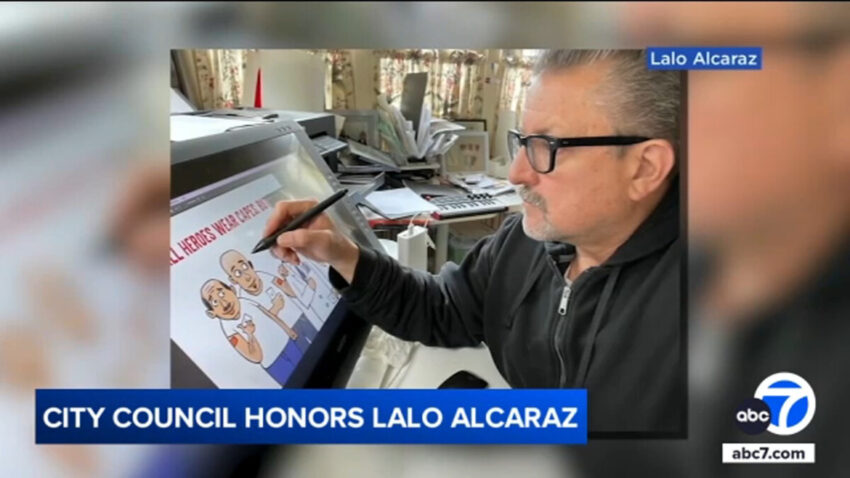
- “Acclaimed political cartoonist Lalo Alcaraz was honored at L.A. City Hall for his contributions to elevate the Latino community,” Eric Resendiz reported Thursday for KABC in Los Angeles. “He’s an influential storyteller who uses his cartoons to turn attention to issues like anti-immigration and racism. . . . Councilmembers also recognized Alcaraz for using his craft during the pandemic. Alcaraz drew cartoons to fight against misinformation on COVID among Latinos. . . .”
- Nikole Hannah-Jones is scheduled to appear at the Martin Luther King Jr. library in Washington, D.C., Sunday to “celebrate the paperback release of The 1619 Project.” But unlike an appearance in nearby Fairfax County, Va., that drew attention for the fee she received, Hannah-Jones “did not charge the Library for her appearance at the Martin Luther King Jr. Memorial Library,” a library spokesman said. [Hannah-Jones messaged June 20, “You can tell readers that I have not charged a speaker’s fee for any of my book tour stops. Not at the Fulton County Library in Atlanta. Not at the Miracle Theater in Inglewood. Not at Underground in Sacramento. Not at St. Paul’s Community Baptist Church in E. New York. “]
 “Vicki Gonzalez (pictured), a longtime media personality in Sacramento who hosts Capital Public Radio’s show “Insight,” announced Monday she has been diagnosed with breast cancer and is taking a leave from hosting the popular program,” Ishanti Desai reported June 10 for the Sacramento Bee.
“Vicki Gonzalez (pictured), a longtime media personality in Sacramento who hosts Capital Public Radio’s show “Insight,” announced Monday she has been diagnosed with breast cancer and is taking a leave from hosting the popular program,” Ishanti Desai reported June 10 for the Sacramento Bee.
- “In January, eight reporters set out to report stories about the Native American Graves Protection and Repatriation Act, or NAGPRA for short, as part of the course work for a master’s degree in investigative reporting at the Walter Cronkite School of Journalism and Mass Communication,” reported Chad Bradley, Aspen Ford and Christopher Lomahquahu of Cronkite News and the Howard Center for Investigative Journalism at Arizona State University. Their investigation into Indigenous remains repatriation found that Arizona universities vary on compliance. (Credit: YouTube)
- “Sean ‘Diddy’ Combs has returned his symbolic key to New York City after Mayor Eric Adams said a committee recommended ‘nullifying and rescinding’ it,” Alli Rosenbloom and Gloria Pazmino reported Sunday for CNN. “Combs was asked to return the key after video footage obtained by CNN showed him physically assaulting his then-girlfriend Cassie Ventura in 2016, according to a June 4 letter Adams sent to Combs. . . .”
- “Sundar Pichai, the chief executive of Google, said in a New York courtroom on Friday that he never discussed a possible takeover of Ozy Media,” Danielle Kaye reported for The New York Times. “Mr. Pichai is the highest-profile witness to testify so far in the trial of Carlos Watson, the founder of Ozy who is accused of misrepresenting his company’s financial results, funding and audience data to investors and lenders from 2018 to 2021. . . . Mr. Pichai drew a clear distinction between what Google had actually considered and an outright acquisition of Ozy. He never discussed a possible takeover — and he never floated a $600 million figure, he told a jury on Friday in U.S. District Court in the Eastern District of New York. . . .”
- “Authorities in the Democratic Republic of the Congo should impartially investigate the June 5 assault of broadcast journalist Tatiana Osango and ensure those responsible are held to account,” the Committee to Protect Journalists said Wednesday. “Seven men used glass bottles to hit Osango, a reporter who presents a political program on the privately owned YouTube-based news channel Réaco News, on her mouth and leg at a restaurant in the capital, Kinshasa, according to multiple news reports and the journalist who spoke to CPJ. Osango told CPJ that the men said they were members of Forces of Progress, an informal youth group claiming to be associated with the ruling party Union for Democracy and Social Progress (UDPS). . . .”
To subscribe at no cost, please send an email to journal-isms+subscribe@groups.io and say who you are.
Facebook users: “Like” “Richard Prince’s Journal-isms” on Facebook.
Follow Richard Prince on Twitter @princeeditor
Richard Prince’s Journal-isms originates from Washington. It began in print before most of us knew what the internet was, and it would like to be referred to as a “column.” Any views expressed in the column are those of the person or organization quoted and not those of any other entity. Send tips, comments and concerns to Richard Prince at journal-isms+owner@
View previous columns (after Feb. 13, 2016).
View previous columns (before Feb. 13, 2016)
- Diversity’s Greatest Hits, 2018 (Jan. 4, 2019)
- Book Notes: Is Taking a Knee Really All That? (Dec. 20, 2018)
- Book Notes: Challenging ’45’ and Proudly Telling the Story (Dec. 18, 2018)
- Book Notes: Get Down With the Legends! (Dec. 11, 2018)
- Journalist Richard Prince w/Joe Madison (Sirius XM, April 18, 2018) (podcast)
- Richard Prince (journalist) (Wikipedia entry)
- February 2018 Podcast: Richard “Dick” Prince on the need for newsroom diversity (Gabriel Greschler, Student Press Law Center, Feb. 26, 2018)
- An advocate for diversity in the media is still pressing for representation, (Courtland Milloy, Washington Post, Nov. 28, 2017)
- Morgan Global Journalism Review: Journal-isms Journeys On (Aug. 31, 2017)
- Journal-isms’ Richard Prince Wants Your Ideas (FishbowlDC, Feb. 26, 2016)
- Richard Prince with Charlayne Hunter-Gault, “PBS NewsHour,” “What stagnant diversity means for America’s newsrooms” (Dec. 15, 2015)
- Book Notes: Journalists Follow Their Passions
- Book Notes: Journalists Who Rocked Their World
- Book Notes: Hands Up! Read This!
- Book Notes: New Cosby Bio Looks Like a Best-Seller
- Journo-diversity advocate turns attention to Ezra Klein project (Erik Wemple, Washington Post, March 5, 2014)
Page count: 681 at 3:41 a.m. 6-20-24; 614 at 4:03 a.m. 6-20-24

